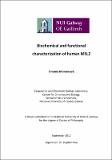| dc.description.abstract | DNA in Eukaryotic cells is complexed with histone proteins to form chromatin. This mediates DNA packaging into the nucleus but also facilitates the regulation of all DNA-templated processes, including transcription, replication and DNA repair. This regulation is achieved in part through modification of the histone proteins by specific enzymes. Genetic screens in Drosophila melanogaster have identified the MSL (male specific lethal) proteins as crucial factors in the regulation of transcription during dosage compensation. Human orthologues of these proteins exist, and have been shown to play roles in regulating transcription and in the DNA damage response.
The human MSL2 (hMSL2) protein is a poorly characterized component of this human MSL complex. As the Drosophila orthologue is the master regulator in dosage compensation, and as the human MSL complex has been implicated in cancer, it is important to fully understand the function of hMSL2.
hMSL2 is a RING finger domain-containing protein. Many RING finger proteins were recently identified as E3 ubiquitin ligases, which catalyse the transfer of the protein Ubiquitin onto specific substrates. In Chapter 3 of this thesis we investigate whether hMSL2 possesses E3 ubiquitin ligase activity. During the course of this study, hMSL2 was indeed identified as an E3 ubiquitin ligase by two other research groups, and was shown to ubiquitylate p53 and histone H2B. These results and the knowledge that other hMSL proteins, hMOF (males absent on the first) and hMSL1, are involved in DNA repair pathways prompted us to investigate whether hMSL2 plays a role in the DNA damage response. In chapter 4 we describe the tools generated to address this possibility. In chapter 5 we demonstrate that hMSL2 is involved in the NHEJ (non homologous end¿joining) repair pathway, that it becomes quickly stabilized in response to DNA damage, and that it possibly mediates the modification of 53BP1, hMSL1 and hMOF.
Together, these results identify hMSL2 as a novel component in the DNA damage response in human cells. | en_US |


